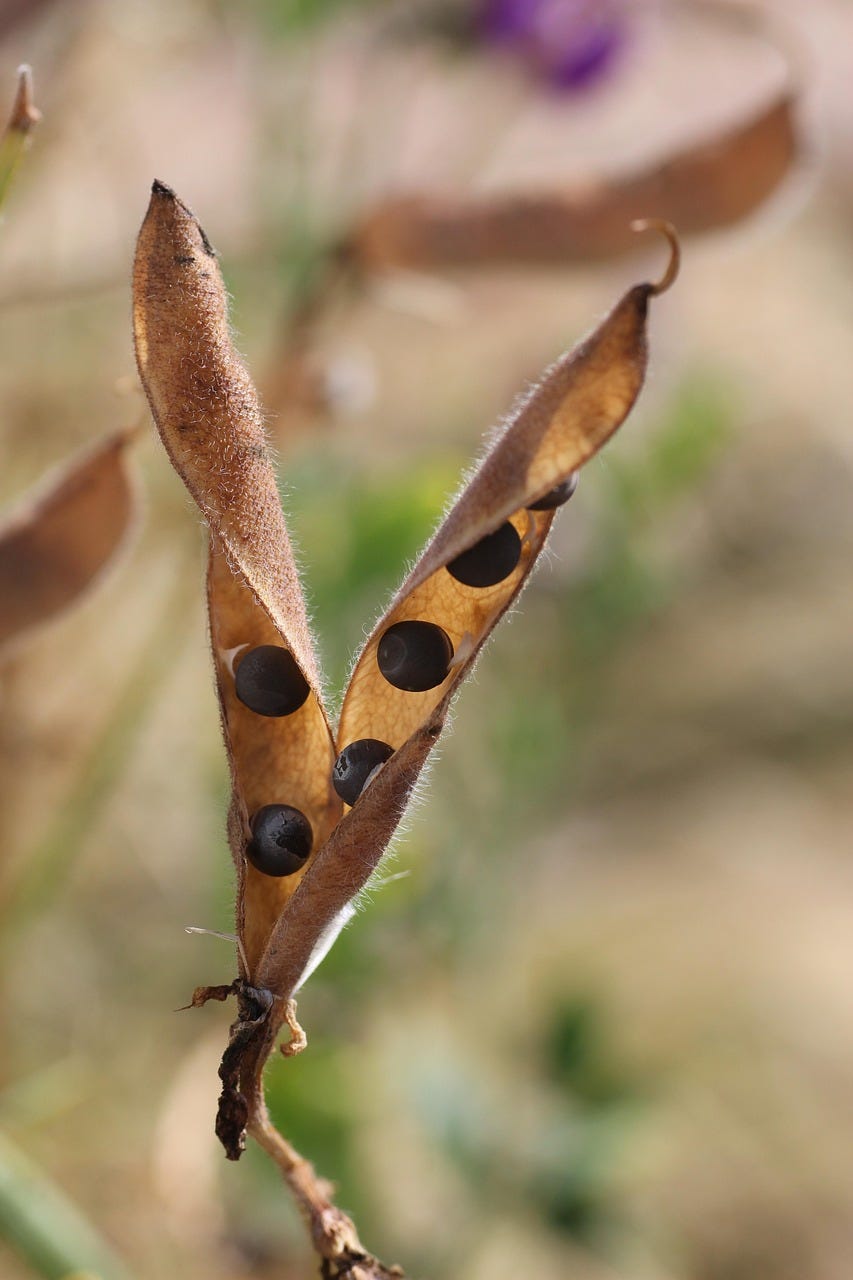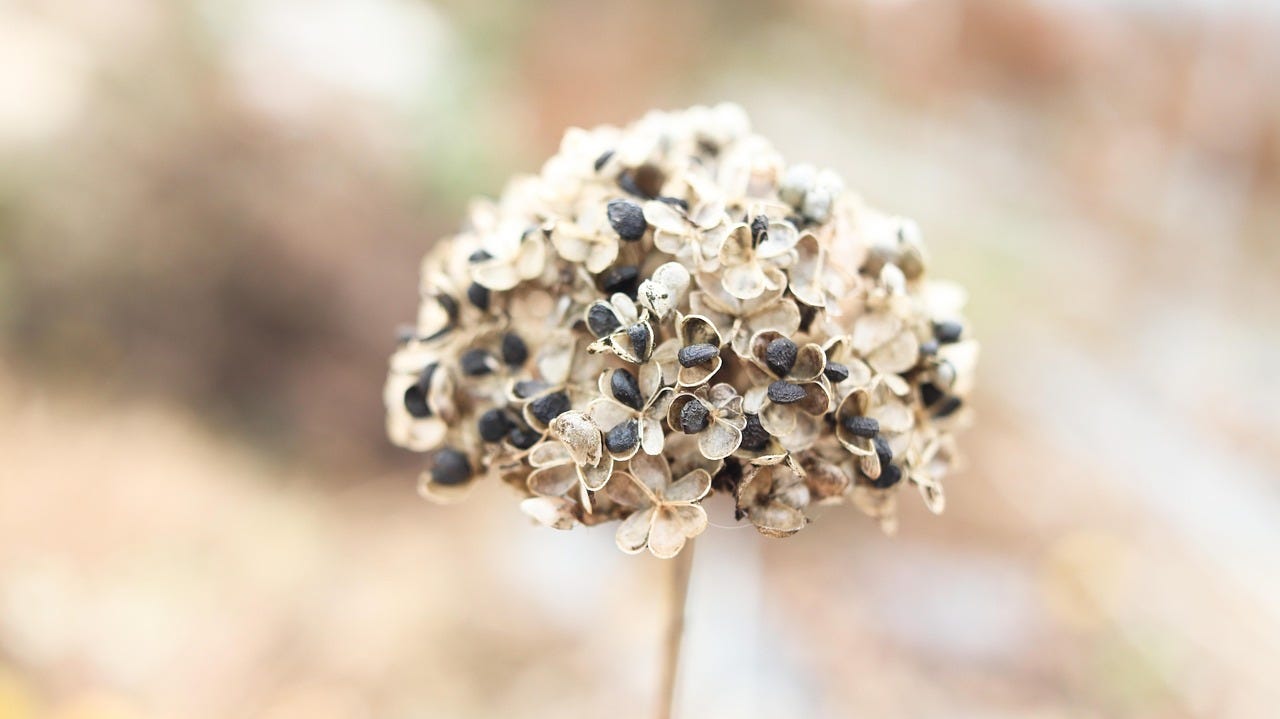Save Our Seeds, Part 2: Is seed saving illegal?
Apple is not the only thing Honeycrisp and iPhone have in common. Both are also patented. And that affects your food. Let's look at solutions and how you can take action.
Dear Climate Culinarians,
How do people keep saving seeds – possibly saving our food supply along the way? And what kind of action can you take to help? That’s what this week’s newsletter is about. If you wonder what I’m talking about – seed saving ??? – take a look at Part 1 of Seed Saving Month, “Why local heirloom vegetables are important”. For now, let’s get back to the problem with seed saving for a second.
Can you grow a pea plant, let the pod dry out, then shake out a little pea and grow a new plant from it? Sure you can. It’s pretty easy, actually. However, it might not be legal.

Is seed saving illegal? It depends!
When someone owns a plant, you can buy their seeds and grow them. But you cannot collect these plants’ seeds and then grow new plants. That’s illegal. So how big a problem is this?
Patented veggies sprout whereever you look. Agro-chemical giant Bayer owns more than 20 different kinds of lettuce and more than 130 kinds of peppers. And that’s just one company. A report by the International Panel of Experts on Sustainable Food Systems from 2017 found:
Worldwide, 60% of these proprietary seeds are controlled by just four companies. Their names are Bayer, Corteva, ChemChina-Syngenta and BASF.
Patent law is complicated, and big companies have the means to enforce it. The result: Seed saving can be risky. And small seed companies have little room for experiments.

By experiments, I mean exactly the type of research meant to secure our food supply: breeding more plants. So that if one type of broccoli is wiped out by a disease, farmers can grow a different variety. But even when someone breeds a new kind of broccoli themselves, and from a non-patented seed, chances are the plant will resemble the description in someone’s patent (here’s an example for a broccoli patent if you’re curious). That similarity could get them into trouble.
Meanwhile, the patent holders insist that seed patents are great for everyone, from farmers to consumers to society as a whole (if you want to explore their position, here’s how BASF advertises its seed patents).
Nevertheless, seed saving is - dare I say - thriving.
Because there still are some non-patented seeds around.
And there are people who advocate for the common good. In the shape of food sovereignty or biodiversity, for instance.
Seed saving for the future: 4 inspiring initiatives
Rummaging in a treasure trove of solutions is my favorite part of research. And this seed business really reminds me: We already have what we need to address climate change and social issues.
An Alternative to Seed Patents
Remember the Honeycrisp/iPhone analogy from earlier? Now think of the software that operates your smartphone or computer. It’s proprietory - you have to agree to a gazillion things to be allowed to use it, and you can’t change a bit. Which sparked an open source software movement. And low and behold, there is a similar movement for seeds: the Open Source Seed Initiative (OSSI). Plant breeders can link a seed to the OSSI Pledge and ensure that others can save these seeds, grow them, adapt them, even use them to breed new varieties.
Bringing Seeds Home
In North America, heirloom beans, corn or melons don’t just go back 50 years. Some plant varieties have been grown for hundreds, if not thousands of years. That’s why the Native American Food Sovereignty Alliance runs the Indigenous Seed Keepers Network. One of its focus areas is rematriation: Bringing seeds stored away in museums etc. back to the place where they were originally grown, before its Native American farmers were forced to relocate.
Borrow Seeds Like Books (and yes, returns are expected!)
Seed libraries are a thing - and you’ll find them in regular libraries. The ones where you borrow books. Only that you borrow seeds for carrots, sunflowers or beans, grow them at home, let some go to seed - and return some of the new seeds you saved to the library. Many seed libraries offer intro classes, some require them for new members. For inspiration: The Seed Library in Pima County, Arizona has excellent resources.
Very, Very Ambitious Seed Savers
The 2024 World Food Prize went to two seed savers. Well, seed savers may be an understatement. Geoff Hawtin and Cary Fowler received the award for or being “instrumental” in establishing the Svalbard Global Seed Vault. The what now? This cavernous bunker, deep under permafrost currently stores backups from more than a million seed samples: wheat, potatoes, chickpeas, baobab - all kinds of food plants, in so many varieties. And it is still being filled! The building is nicknamed “doomsday vault”, because it serves as a safety net. In case the preferred varieties of food plant are failing. We could even start growing more types of plants as everyday food than today. That, dear Climate Culinarians, may become a seperate newsletter one day … do you want me to write it?
Take Action: What you can do to save seeds - with or without a garden
Everyone can take action for veggie diversity and seed saving. Obviously, it helps to have a sunny space for a few plant pots or a garden bed. But you can support these efforts in other ways, too.

Bring seeds to the (conversation) table!
Talk to friends and family about your favorite veggie’s origin (aka seeds). Perhaps while you enjoy a meal.
Take your kids on a treasure hunt in the supermarket: Can you spot the differences between apple varieties?
Plan a „bring your heirloom“ brunch.
If you are one of the lucky people who get to shop at a farmers market or farm stand: Ask if they ever save seeds. Or ask the name of a veggie/fruit variety on the table and why they prefer to grow this particular one.
Chat with local gardeners or horticulturalists and learn which plant varieties thrive in your local growing conditions, and ask if they save their seeds.
Contact your local news outlet and ask them to run a piece about local seed saving initiatives.
Volunteer or donate to an organization that has a seed saving program or runs policy campaigns.
Just as an inspiration, volunteer options include working the garden at the Native Seeds/SEARCH Conservation Center in Tucson, Arizona.
Some seed banks or seed libraries also involve volunteers in packaging, answering requests or ask for help with educational events and advocacy campaigns.
Become a seed saver yourself
Learn how to save seeds in your garden or from your potted herbs.
Learn how to store your seeds as well.
Then try both this season!
Find out if your local library has a seed library (here’s a map). Volunteer, spread the word, or help start one.
Yeah, I know, this last bit screams for seed saving resources. Luckily, next week is reading recs week! But don’t you worry that it’s going to be instructions bonanza while you wouldn’t consider caring for a cactus. I will include a book full of seed saving know-how, but there will also be a thrill… nope, you gotta wait and read.
Eat, read, repeat!
Petrina
Climate Culinarians is a project by me, Petrina Engelke. I write about climate, food and the U.S., and I help other writers turn their ideas into a book people want to read. In other words: I’m a journalist and a book coach.



Interesting! I had no idea that seeds could be patented. This is good information.